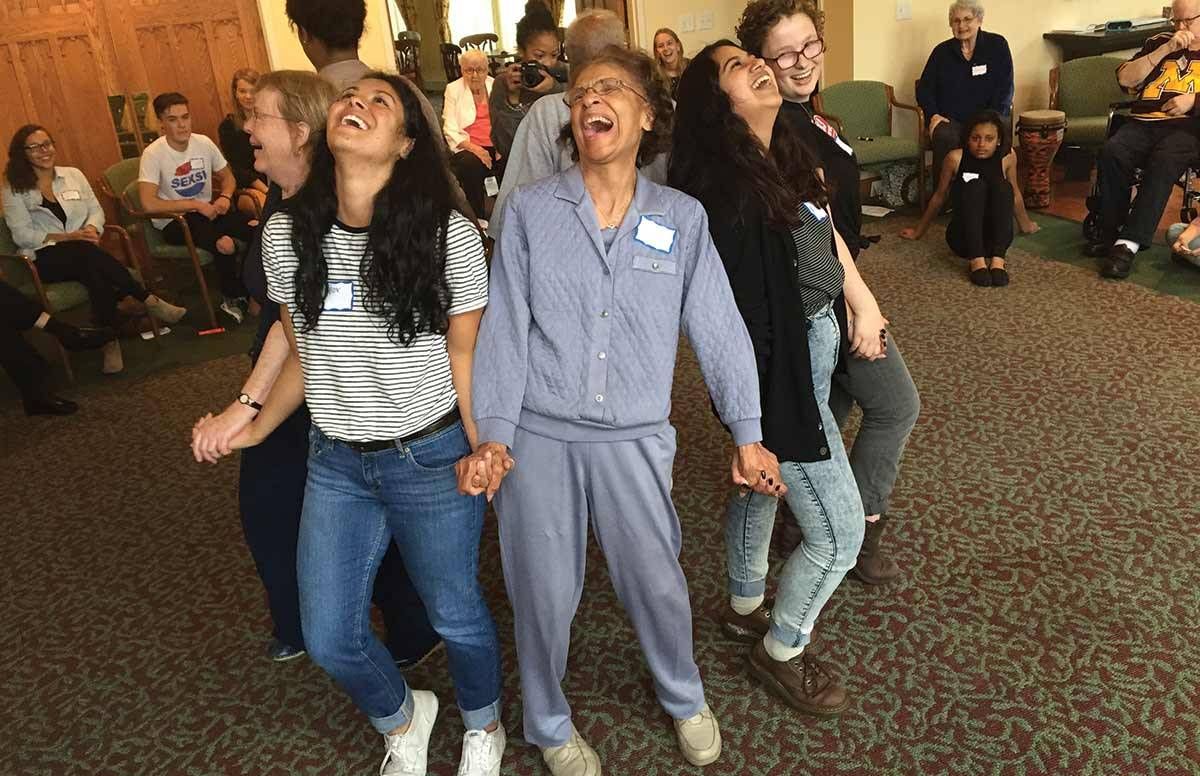This 'Peter Pan' Production Truly Is Ageless
Ageism flew out the window when high schoolers and older adults put on the play
Their first job was choosing a play — one that would make sense for high school students and residents at a senior living facility to produce together. They decided to tell a story that had been around longer than anyone in sitting in the room at Episcopal Homes in St. Paul, Minn.

The oldest person in that room was 101. Peter Pan, it turned out, was even older. J.M. Barrie’s play about an ageless flying boy premiered in 1904. They had their show.
Their adaption of Peter Pan fully integrated the two generations as acting colleagues. A student played Peter Pan; a senior living resident was cast as Tinker Bell. An older actor played Captain Hook; a teenager was cast as his lackey, Smee. Age played a role in some casting decisions: high schoolers played Lost Boys who stayed in Neverland and never grew up, while older actors played Lost Boys who had left Neverland and grown older.
Or as the notes used to develop the script put it: “We were all at Neverland together — the seniors were the ones who had left — really we are all the same age. Growing up in your heart vs. body. [Captain] Hook represents boredom or fear of getting older.”
In the end, their intergenerational theater production — performed last winter at Episcopal Homes — had the young-faced Lost Boys on a mission to defeat Captain Hook and rescue their older-looking friends, restore their lost youth and teach them to fly again.
The Benefits of Theater for Older Adults
Joey Clark, a teacher at St. Paul Conservatory for Performing Artists (a public charter arts high school) and chair of the musical theater program there, said he was inspired to create an intergenerational theater experience by other senior theater programs that have been springing up across the country. So he collaborated with Episcopal Homes, an organization that offers a range of senior living facilities in St. Paul, and created a class.
“The health benefits that come from applause, I often say, are better than a trip to the doctor,” says Bonnie Vorenberg, president of ArtAge's Senior Theatre Resource Center. According to Vorenberg, in 1997, there were about 100 senior theater companies; today there are nearly 800. “Seniors are largely invisible," she says. "The theater gives them a voice."
Research points to other benefits as well.
For two decades, Helga and Tony Noice, husband and wife faculty members of Chicago-area Elmhurst College, have conducted research showing that theater arts enhances healthy cognitive aging. Tony, a professional actor who teaches theater at the college, says the work he has done with his wife, a psychology professor, shows that getting older people to act improves cognitive skills like problem solving and word memory and indicates that the beneficial effect of acting on the brain seem to be stronger than participating in other creative activities, such as singing or visual arts.
He believes that’s because acting stimulates physical, emotional and mental abilities at the same time and because it requires memory recall, yet staying in the present moment.
“It taps your analytic ability, as well as your intuitive ability, as well as your kinesthetic ability,” says Gay Hanna, executive director of the National Center for Creative Aging. In addition, many people feel more comfortable in the spotlight later in life, Hanna says. “Older people are more likely to have the psychological perspective to think 'If not now, when?' and 'What can they do to me?'” she adds.
Trying Something New
“I had to wait to be 85 to be an actor,” says Doris Douglas, a Peter Pan cast member. “It shows me I’m still learning. I’m not too old to learn.”
Clark’s class is different from a lot of senior theater programs because of the intergenerational collaboration between high schoolers and older adults. The students in the class were veteran actors, but many of the older performers, like Douglas, had never acted before.
“It’s scary because it’s outside my comfort zone,” says Marijo Hickok, 78. “I think about this all the time. I’m finding out I can do some things I didn’t think I wanted to do.”
Over the course of three months, the class progressed from acting exercises, improv activities and memory work to writing a play together, rehearsals and their performance before an audience.
Ranging in age from late 70s to over 100, the older actors had a range of physical and cognitive abilities. But despite some memory lapses, “they’re all aware they’re in a scene. When they’re in Neverland, they’re in Neverland. Nobody says, ‘I’ve got to go to the bathroom,’” Clark says.
But there were some bloopers during rehearsals. Like the time Douglas forgot what her role was. “I am … what am I?” she asked. “You’re a pirate,” said Savannah Broadnax, 17.
Douglas said the hardest part of the show was “trying to remember my line. And I only had one line.” And when someone gave her the traditional pre-show encouragement to “break a leg,” she responded, “Oh, please don’t say that, because I might.”
Both the teenagers and the older adults came away with a new picture of the other generation.
“The energy of the young people gives me energy," said Hickok.
“I actually didn’t expect how willing the young-at-hearts, as we call them, were to get into the show,” said Reyna Binondo, 18.
Eighteen-year-old Dorine Jinkins summed it up nicely: “It doesn’t matter how old you are. You can really love theater no matter what.”

